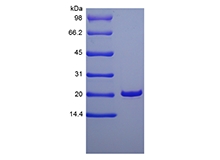| Official Full Name |
Recombinant Human Keratinocyte Growth Factor 1/FGF-7 (rHuKGF-1/FGF-7) |
| Squence |
 |
| Amino Acid Sequence |
CNDMTPEQMA TNVNCSSPER HTRSYDYMEG GDIRVRRLFC RTQWYLRIDK RGKVKGTQEM KNNYNIMEIR TVAVGIVAIK GVESEFYLAM NKEGKLYAKK ECNEDCNFKE LILENHYNTY ASAKWTHNGG EMFVALNQKG IPVRGKKTKK EQKTAHFLPM AIT |
| Synonyms |
HBGF-7 |
| Accession Number |
P21781 |
| GeneID |
2252 |
| Summary |
Human KGF-1 also known as Fibroblast growth factor 7 (FGF-7), is encoded by the FGF7 gene. KGF-1 only binds to the b splice form of the tyrosine kinase receptor, FGFR2b/KGFR. Affinity between KGF-1 and its receptor can be increased by heparin or heparan sulfate proteoglycan. FGF-10, also called keratinocyte growth factor 2 (KGF-2), shares 51 % amino acid sequence identity and similar function to KGF-1, but uses an additional receptor, FGFR2c. KGF-1 plays an important role in the regulation of embryonic development, cell proliferation and cell differentiation. KGF-1 actives on keratinocytes, and exhibits mitogenic activity for epidermal cells, but essentially no activity for fibroblasts. KGF-1 has species crossactive, human KGF-1 shares 96 % amino acid sequence identity with murine, and 92 % with rat. |
| Source |
Escherichia coli. |
| Molecular Weight |
Approximately 18.9 kDa, a single, non-glycosylated polypeptide chain containing 163 amino acids. |
| Biological Activity |
Fully biologically active when compared to standard. The ED50 as determined by thymidine uptake assay using FGF-receptors transfected BaF3 cells is less than 10 ng/ml, corresponding to a specific activity of > 1.0 × 105 IU/mg. |
| Appearance |
Sterile filtered white lyophilized (freeze-dried) powder. |
| Formulation |
Lyophilized from a 0.2 um filtered solution in 20 mM PB, 0.5 M NaCl, pH 8.0. |
| Endotoxin |
Less than 1 EU/ug of rHuKGF-1/FGF-7 as determined by LAL method. |
| Reconstitution |
We recommend that this vial be briefly centrifuged prior to opening to bring the contents to the bottom. Reconstitute in sterile distilled water or aqueous buffer containing 0.1% BSA to a concentration of 0.1-1.0 mg/mL. Stock solutions should be apportioned into working aliquots and stored at ≤ -20 °C. Further dilutions should be made in appropriate buffered solutions. |
| Stability and Storage |
Use a manual defrost freezer and avoid repeated freeze-thaw cycles.- 12 months from date of receipt, -20 to -70 °C as supplied.- 1 month, 2 to 8 °C under sterile conditions after reconstitution.- 3 months, -20 to -70 °C under sterile conditions after reconstitution. |
| References |
|
| SDS-PAGE |
 |
| Safety Data Sheet (SDS) Download |
Click to download |
| Technical Data Sheet (TDS) Download |
Click to download |



